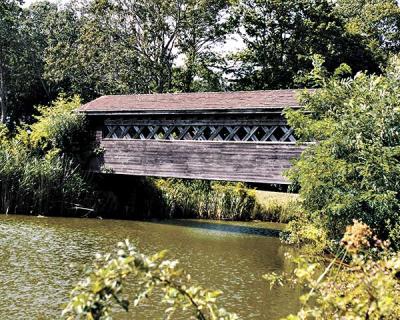A Touch of Madison County

Nestled among houses just north of Montauk Highway in a neighborhood known as Ludlow Greens in Bridgehampton is a covered wooden bridge, which creates a bucolic vista and surprises those who come across it for the first time.
Over a narrow section of a manmade pond, the bridge, in a hamlet that dates back to the 17th century, can be called a curiosity, though it is only decades old. Built as part of a subdivision that was developed starting in around 1990, it may not be historically correct, but it offers an enviable view and a tranquil respite for those fortunate enough to live there, or fortunate enough to have discovered it.
“It’s a quiet little oasis,” Melissa Osborne, whose house was the second built at Ludlow Greens about 25 years ago, said.
The idea was attributed to Roy Wines Jr., the Southampton Town Planning Board chairman at the time, according to a Jan. 28, 1988, article in The East Hampton Star about the subdivision plan. Mr. Wines said he had tried to convince developers to incorporate a covered bridge into a subdivision for years, and talked it up enthusiastically. He said it resembled “a little New England” when final approval came from the planning board in October of that year.
For the developers, it offered an aesthetic solution for a parcel on the 24-acre subdivision that was constrained by a fresh wetland and considered unbuildable, according to Ms. Osborne.
The rustic wooden bridge and pond are on a 2.5-acre lot at the end of Edgewood Avenue, at the north end of Ludlow Greens, which is named for the farming family who once owned the land. Seventeen houses were built around the cul-de-sacs of Edgewood Avenue and Ludlow Green.
“Originally, the developer had proposed extending the pond under the road with a covered bridge for vehicular traffic, but Suffolk County planners opposed the height limitation the bridge’s roof would impose,” The Star reported back in 1988.
Several other Bridgehampton developments north of the highway were approved at about the same time, such as the controversial Bridgewood subdivision of 101 acres off the Bridgehampton-Sag Harbor Turnpike. “Bridgehampton sort of went through a revival. It used to be a town that you sort of drove through,” Alfred Tuff, a builder who eventually took over the project, said. He put up 15 houses at Ludlow Greens in Colonial Revival style, and went on to build 13 other houses on nearby Alfie’s Way.
As it turned out, the initial developers of Ludlow Greens, Gilbert, Jonathan, and Christopher Foster, didn’t get much further than creating the pond and building the bridge before they were forced to sell. The bridge’s lattice trusses, which are about 50 feet long, were handmade in Pennsylvania and brought to Ludlow Greens, Mr. Tuff said. “Without Jon it wouldn’t have happened. He really set the bar very high,” he said.
“There are no other covered bridges on the eastern end of Long Island that I know of, or on Long Island for that matter,” said Kitty McCoy, an architect who has a house in Ludlow Greens. She is the president of the homeowners association, which maintains the property. “It’s sort of a bridge to nowhere,” she said with a laugh.
Though on private land, it is a must-stop spot for some East Enders in the know. Parents stop by with young children to peek through the lattice work for a glimpse of the turtles and frogs that call the pond home. “Clap your hands and they all come swimming out and look up at that bridge,” Ms. Osborne said. “There are beautiful koi in that pond, blue heron that stop there. We had a goose pair that had goslings there.” Just-married couples will stop for photographs with the bridge as a picturesque backdrop. Then there are those in the throes of young love who steal kisses under the bridge’s cover.
The bridge is without a doubt a selling point for the 17 houses in the subdivision. David Butland, a Corcoran real estate broker who has a rental listing there now, said with certainty of the property owners, “The view of the bridge is a big reason they bought it.” He called the bridge an asset to the community with its country charm and nostalgic feeling. “It adds a little something,” he said. “It makes people smile.”
